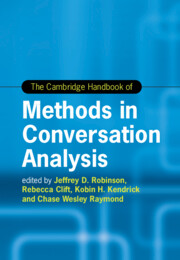Book contents
- Frontmatter
- Contents
- List of Tables
- List of Contributors
- Part I Introduction
- Part II Points of Departure
- 2 Conversation-Analytic Methods of Data Collection
- 3 Collecting Interaction Data in the ‘Lab’ versus the ‘Field’: Rationale, Ramifications, and Recommendations
- 4 Working with Data I: Field Recordings
- 5 Multimodal Transcription as Process and Analysis: Capturing the Audible and Visible
- 6 Discovering a Candidate Phenomenon
- 7 Data Sessions
- Part III Collections
- Part IV Evidence
- Part V Avenues into Action
- Part VI Situating and Reporting Findings
- Part VII Looking Forward
- Appendix I Jeffersonian Transcription Conventions
- Appendix II Multimodal Transcription Conventions
- Index
5 - Multimodal Transcription as Process and Analysis: Capturing the Audible and Visible
from Part II - Points of Departure
Published online by Cambridge University Press: 06 December 2024
- Frontmatter
- Contents
- List of Tables
- List of Contributors
- Part I Introduction
- Part II Points of Departure
- 2 Conversation-Analytic Methods of Data Collection
- 3 Collecting Interaction Data in the ‘Lab’ versus the ‘Field’: Rationale, Ramifications, and Recommendations
- 4 Working with Data I: Field Recordings
- 5 Multimodal Transcription as Process and Analysis: Capturing the Audible and Visible
- 6 Discovering a Candidate Phenomenon
- 7 Data Sessions
- Part III Collections
- Part IV Evidence
- Part V Avenues into Action
- Part VI Situating and Reporting Findings
- Part VII Looking Forward
- Appendix I Jeffersonian Transcription Conventions
- Appendix II Multimodal Transcription Conventions
- Index
Summary
Social interaction is inescapably multimodal, composed of talk (e.g., lexical items, syntax, prosody), nonlexical conduct (e.g., breathing, laughter, sighing, response cries), and solely visible (or embodied) conduct (e.g., body posture and movement, hand gestures, object manipulation). While this chapter concerns the transcription of social interaction, its primary goal is not to explain transcription conventions and instruct readers how to use them (these topics are dealt with secondarily). Rather, the primary goal of this chapter is to demonstrate the analytic necessity and usefulness of systematic and detailed transcription practices, including those for both vocal and visual conduct (e.g., systems developed by Gail Jefferson and Lorenza Mondada, respectively). We achieve this goal by applying a wide range of transcription practices to a single video clip of mundane, dinner-time English conversation, illustrating how transcription both is, and contributes to, an analytic process. We discuss practical difficulties associated with transcription, especially that of visual conduct. Ultimately, we show that transcription is essential to understanding topics such as turn-taking, sequentiality, (dis)affiliation, emotion, stance, and social action itself.
Keywords
- Type
- Chapter
- Information
- The Cambridge Handbook of Methods in Conversation Analysis , pp. 115 - 142Publisher: Cambridge University PressPrint publication year: 2024

